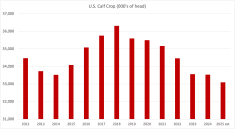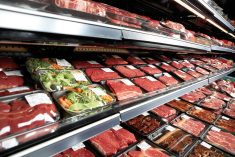Exports are the lifeblood of the U.S. beef industry, even more so than in Canada if one excludes its exports south. U.S. exports added more than US $476 to the value of each fed steer or heifer in the first seven months of this year. From virtually no beef export sales in the 1970s, the U.S. in 2021 exported 1.44 million metric tonnes of beef and beef variety meat worth US$10.58 billion.
Exports per head of fed slaughter last year equated to a record US$407, up a whopping 35 per cent from 2020. But the beef export juggernaut has gathered even more pace this year, hence the 17 per cent increase in per-head value versus all of last year. Exports to the end of July topped US$1 billion in six months out of seven and were likely to do so again in August and September.
[More Prime Cuts with Steve Kay]
Read Also

Cattle Market Summary
Break-evens, cow and calf prices, plus market summaries courtesy of Canfax and Beef Farmers of Ontario. Cost of Production September…
Exports totalled US$1.006 billion in July and posted the fifth-largest volume on record for the month. They totalled 126,567 mt, up three per cent year-over-year. For the first seven months of 2022, beef exports increased six per cent from a year ago to 870,471 mt, valued at US$7.2 billion (up 29 per cent). If the same rate keeps up from August through December, exports would hit a new volume record of 1.49 million mt and a new value record of US$12.34 billion, according to my calculations.
July beef export value equated to US$472.75 per head of fed slaughter, up 11 per cent from a year ago. The January-July average was US$476.38 per head, up 29 per cent. Exports accounted for 16.4 per cent of total July beef production and 14.1 per cent for muscle cuts only, each up about one percentage point from last year. The January-July ratios were 15.5 per cent and 13.3 per cent, up from 12.6 per cent and 14.8 per cent, respectively, a year ago.
[RELATED] Feds pledge agriculture office for Indo-Pacific export support
As U.S. Meat Export Federation president and CEO Dan Halstrom noted in August, global demand for U.S. beef continues to be amazingly resilient, especially at the retail level. Exports have also benefited from a partial rebound in the food service sector but this recovery is far from complete.
Japan, as it has been for some years, remained the leading volume market in July. Exports there reached 30,726, up eight per cent from a year ago, valued at US$231.6 million (up three per cent). This pushed January-July exports one per cent above last year’s pace at 186,239 mt, while value climbed 17 per cent to US$1.49 billion. For beef variety meat, mainly tongues and skirts, exports to Japan were steady with last year at 33,581 mt but value jumped an impressive 38 per cent to nearly US$340 million.
[RELATED] Market Intelligence Update from Canada Beef: Canadian beef exports drop in August
Japan’s importance as an export market is even more important when one considers that until 1978, the U.S. exported little beef to Japan, usually less than 10,000 mt per year. However, the Strauss-Ushiba Understanding of that year between the U.S. and Japan allowed for an increase in the quota for high-quality grain-fed beef from 16,800 mt in 1978 to 30,800 mt in 1983. By 2012, the U.S. exported 152,763 mt of beef produced there worth US$1.03 billion. These numbers more than doubled by 2021, when export volumes hit 320,735 mt worth US$2.38 billion.
It was especially fitting therefore that leaders representing the U.S. red meat industry in September travelled to Tokyo to commemorate the 45th anniversary of the inaugural USMEF office, which opened in Tokyo in 1977. Japan has consistently been a top customer and is the leading international market for U.S. red meat, purchasing nearly US$4.1 billion in 2021, says USMEF. Through July 2022, U.S. red meat exports to Japan reached US$2.4 billion.
















